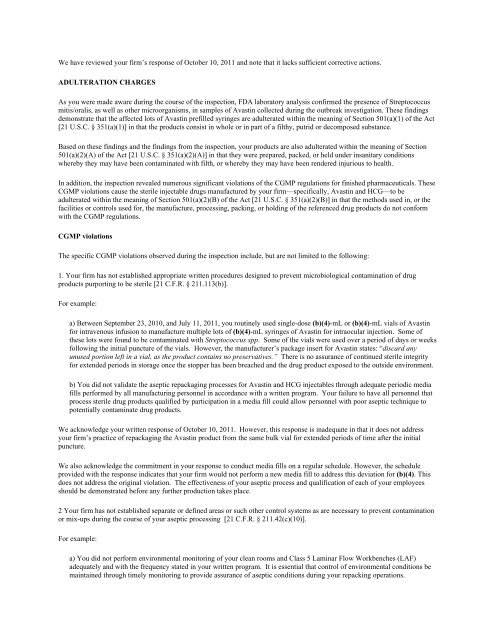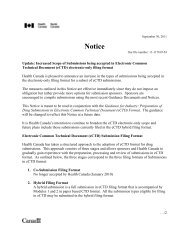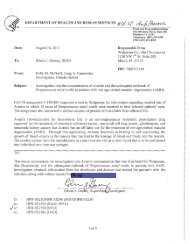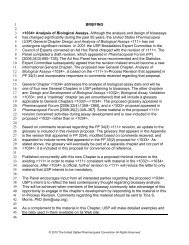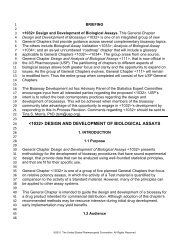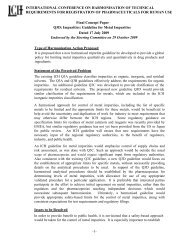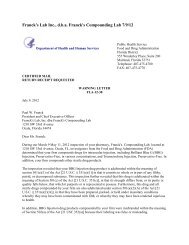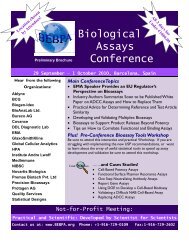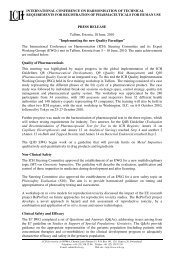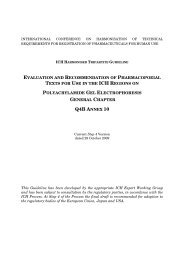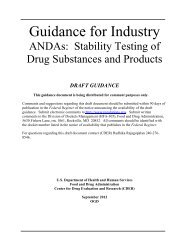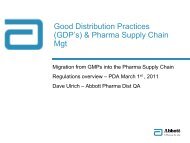FDA warning letter - IPQ
FDA warning letter - IPQ
FDA warning letter - IPQ
You also want an ePaper? Increase the reach of your titles
YUMPU automatically turns print PDFs into web optimized ePapers that Google loves.
We have reviewed your firm’s response of October 10, 2011 and note that it lacks sufficient corrective actions.<br />
ADULTERATION CHARGES<br />
As you were made aware during the course of the inspection, <strong>FDA</strong> laboratory analysis confirmed the presence of Streptococcus<br />
mitis/oralis, as well as other microorganisms, in samples of Avastin collected during the outbreak investigation. These findings<br />
demonstrate that the affected lots of Avastin prefilled syringes are adulterated within the meaning of Section 501(a)(1) of the Act<br />
[21 U.S.C. § 351(a)(1)] in that the products consist in whole or in part of a filthy, putrid or decomposed substance.<br />
Based on these findings and the findings from the inspection, your products are also adulterated within the meaning of Section<br />
501(a)(2)(A) of the Act [21 U.S.C. § 351(a)(2)(A)] in that they were prepared, packed, or held under insanitary conditions<br />
whereby they may have been contaminated with filth, or whereby they may have been rendered injurious to health.<br />
In addition, the inspection revealed numerous significant violations of the CGMP regulations for finished pharmaceuticals. These<br />
CGMP violations cause the sterile injectable drugs manufactured by your firm—specifically, Avastin and HCG—to be<br />
adulterated within the meaning of Section 501(a)(2)(B) of the Act [21 U.S.C. § 351(a)(2)(B)] in that the methods used in, or the<br />
facilities or controls used for, the manufacture, processing, packing, or holding of the referenced drug products do not conform<br />
with the CGMP regulations.<br />
CGMP violations<br />
The specific CGMP violations observed during the inspection include, but are not limited to the following:<br />
1. Your firm has not established appropriate written procedures designed to prevent microbiological contamination of drug<br />
products purporting to be sterile [21 C.F.R. § 211.113(b)].<br />
For example:<br />
a) Between September 23, 2010, and July 11, 2011, you routinely used single-dose (b)(4)-mL or (b)(4)-mL vials of Avastin<br />
for intravenous infusion to manufacture multiple lots of (b)(4)-mL syringes of Avastin for intraocular injection. Some of<br />
these lots were found to be contaminated with Streptococcus spp. Some of the vials were used over a period of days or weeks<br />
following the initial puncture of the vials. However, the manufacturer’s package insert for Avastin states: “discard any<br />
unused portion left in a vial, as the product contains no preservatives.” There is no assurance of continued sterile integrity<br />
for extended periods in storage once the stopper has been breached and the drug product exposed to the outside environment.<br />
b) You did not validate the aseptic repackaging processes for Avastin and HCG injectables through adequate periodic media<br />
fills performed by all manufacturing personnel in accordance with a written program. Your failure to have all personnel that<br />
process sterile drug products qualified by participation in a media fill could allow personnel with poor aseptic technique to<br />
potentially contaminate drug products.<br />
We acknowledge your written response of October 10, 2011. However, this response is inadequate in that it does not address<br />
your firm’s practice of repackaging the Avastin product from the same bulk vial for extended periods of time after the initial<br />
puncture.<br />
We also acknowledge the commitment in your response to conduct media fills on a regular schedule. However, the schedule<br />
provided with the response indicates that your firm would not perform a new media fill to address this deviation for (b)(4). This<br />
does not address the original violation. The effectiveness of your aseptic process and qualification of each of your employees<br />
should be demonstrated before any further production takes place.<br />
2 Your firm has not established separate or defined areas or such other control systems as are necessary to prevent contamination<br />
or mix-ups during the course of your aseptic processing [21 C.F.R. § 211.42(c)(10)].<br />
For example:<br />
a) You did not perform environmental monitoring of your clean rooms and Class 5 Laminar Flow Workbenches (LAF)<br />
adequately and with the frequency stated in your written program. It is essential that control of environmental conditions be<br />
maintained through timely monitoring to provide assurance of aseptic conditions during your repacking operations.


